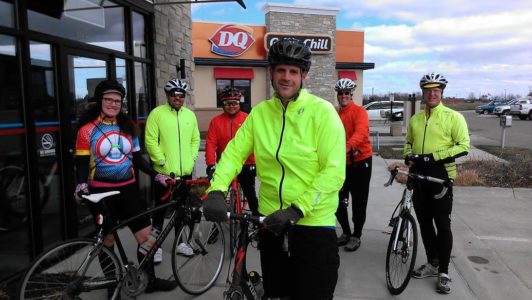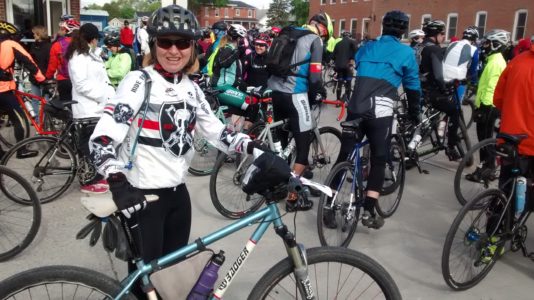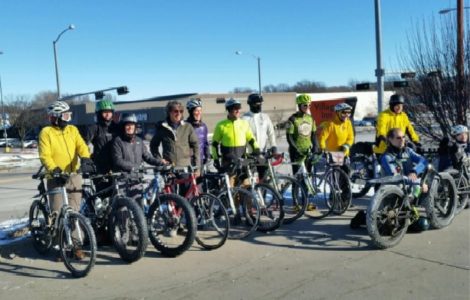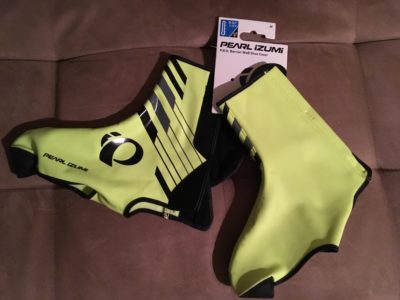So the bike challenge is over, it’s chilly and wet, and the resolve you had to continue bicycling into the fall has left without you. Cool season riding is arriving, though it’s supposed to be back up to 90 degrees later in the week. Much ink is spilled every fall writing about how to cope with cycling in cool and even cold weather, but by far the biggest obstacle is your own mindset. If you decide to do it, you can. When I started riding all through the winter it was because someone I knew did it, and I thought that if HE could do it, I certainly could. Before that, I never really considered it was a possibility. At first I decided to do it as an experiment just one day, to see if it was possible. I did everything wrong. I didn’t research what to wear. My jacket was too warm (not heavy but it didn’t breathe) so I sweat and got wet. I wore cotton layers underneath that held in the sweat. My gloves weren’t warm enough. My feet got cold. My cap was too hot under the helmet, but my neck and face were cold! At least I had allowed plenty of time to navigate in the snow.

Dressing for riding in cool weather is not like dressing for a leisurely walk, and riding in cold weather is more like dressing for shoveling snow or cross-country skiing. At first you will be afraid you haven’t dressed warmly enough because you’re cold, but for the first 10 minutes you should be a little cold. If that’s all the further your ride is, then fine, be comfortable. Otherwise you’ll arrive hot and sweaty unless you have a very leisurely pace. Your pace is also an indicator of how you should dress. I’ve found that even just a couple of mph difference, maybe because you’re riding with a slower person, can be the difference between being perfectly comfortable and feeling like you’re freezing. Your commuting speed and distance may be different than your out-for-a-ride speed, so keep that in mind.

Most guides will tell you to keep a non-cotton wicking base layer next to the skin, a thermal layer such as wool or fleece next, and a wind barrier on the top. Layers are best, as they can be shed or even added to if needed. Many people have gear organized into 10 degree increments, perhaps with sub-categories depending on conditions.

I sure do, depending if I’m commuting or riding out of the city. I’ll admit to staring long and hard at my closet yesterday and today, since it was also wet. My warm weather good-for-getting-wet clothes weren’t going to feel good in cooler temps, and my cold weather thermals would be over doing it. My work pants mostly seem to be cotton blends, bad for getting and staying wet, and taking clothes along to change into doesn’t work for me. For temps in the 40’s my go-to attire is a long-sleeved jersey with arm warmers and a wind vest, leaving the armpits free and not sweaty. From there it’s probably thermal knickers, and socks may or may not be wool depending on where in the 40’s we are and if it’s windy. My cap and full-fingered gloves may be very thin or warmer using the same criteria. This also works if it’s a little wet. For work today I went with a rain-resistant but still breathable single-layer jacket, leggings that did not contain cotton, and a wicking light-weight but warm pullover. Shoes can be tricky, too, as you don’t want to spend your day in wet shoes. In the summer I just wear sandals, but cooler temps mean weather-resistant shoes and non-cotton socks. Even with a rain cape or jacket your feet will get wet. Shoe covers or boots are another option.

Different people find different combinations that work best for them. It doesn’t have to be expensive, but it does need to be thought out. I’ve even heard large water-proofed, coated socks from a farm supply store can go over shoes.
Give it a try. You don’t have to do it every day or in bad weather, but you can experiment. Once I tried it, I was hooked.
